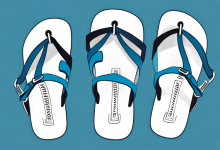Wondering what type of sandal to wear for a summer day at the beach or lake? Read on for an in-depth comparison of beach sandals and water sandals, two of the top contenders. We’ll cover types, advantages and disadvantages, styles and designs, durability, and price comparisons for each. To finish up, we’ll give you a few tips for selecting the right style and type of sandal.
Types of Beach Sandals
Beach sandals are designed to be worn in the hot sun and are best suited for lounging around on the sand or taking a leisurely stroll on the beach. They usually have a single strap or a double strap across the top of the foot, and come in a variety of styles and colours. Common designs include thong sandals (with one thick sole and a Y-shape strap), slip-on sandals (with a single or double strap across the top of the foot), Gladiator sandals (with multiple straps), slide-on sandals (one strap across the top of the foot with no laces or buckles), and open-toe sandals (which feature an open toe).
Types of Water Sandals
Water sandals are designed for outdoor activities such as kayaking, fishing, stand-up paddleboarding, white water rafting, boating, and more. They are made from water-repellent material and often come with heel support, adjustable straps, rubber soles for extra grip, and drainage holes in the sole that allow water out and help keep the foot from sliding around in the shoe. Comfort is key with water sandals, so they often have cushioned footbeds and arch support.
Advantages of Beach Sandals
Beach sandals have some distinct advantages over water sandals, such as being lightweight and flexible. The sole is usually made of foam or rubberized material designed to provide comfort and grip while walking on the sand. Beach sandals generally come in bright colors and stylish designs, with many models offering a variety of options such as straps and decorations. Beach sandals are also great for achieving a tan on your feet without getting sunburned and making it easy to move around.
Advantages of Water Sandals
Water sandals are great for keeping your feet cool in hot weather. The materials used to make water sandals provide maximum breathability and drainage. The rubber soles provide grip on wet surfaces and protect your feet from sharp rocks, jagged edges, and other obstacles that could lead to injury. The adjustable straps allow you to customize the fit for optimum comfort and maximize ankle stability.
Disadvantages of Beach Sandals
Beach sandals have some disadvantages as well. They don’t provide ankle support or arch support, which can lead to injuries when navigating difficult terrain. They also don’t offer water protection, so your feet will be vulnerable to getting wet. Beach sandals are not ideal for activities such as swimming as they can easily slip off when wet. They can be expensive as well, depending on the brand and style you choose.
Disadvantages of Water Sandals
The biggest disadvantage of water sandals is that they can be heavy, which can be tiresome after a long day of activity. Additionally, they often have non-removable insoles that make them difficult to clean. The adjustable straps can wear out quickly after regular use, so they may need to be replaced frequently. Water sandals are not suitable for all kinds of terrains where ankle support is needed; they’re best used in and around water.
Styles and Designs of Beach Sandals
Beach sandals come in a multitude of styles and designs, including flip-flop style thongs, slip-on slides, toe-ring slides, gladiator styles, wedge heels and more. Each style typically has different colorways available for both men and women. There are also stylish embellishments such as cute beading or ribbon lacing that add an extra level of style and appeal to your beach attire.
Styles and Designs of Water Sandals
Water sandals come in more muted colors and muted designs such as neutrals to mochas or navy blue tones. The soles are often thicker than traditional beach sandals and come with a multitude of patterns to maximize grip on different surfaces when wet. As with beach sandals, there are various styles available such as slides, thongs, gladiator designs, ankle straps and shapes that provide maximum comfort and protection.
Durability of Beach Sandals vs Water Sandals
In terms of durability, water sandals have an advantage due to the materials used to make them. The rubber soles provide extra protection against dirt and wear while walking on different surfaces as well as protection against sharp edges. Beach sandals are also quite durable, but they may be worn out more quickly by regular use on humid surfaces or by exposure to salt water.
Price Comparison for Beach Sandals vs Water Sandals
The cost of beach sandals and water sandals varies depending on the brand and style you choose. Generally speaking, beach sandals tend to be slightly more affordable than water sandals due to their lighter construction materials and lack of extra features such as arch support or adjustable straps. Water sandals may cost anywhere from $30 to $130 depending on the brand, while beach sandals start at around $10.
Tips for Choosing the Right Style and Type of Sandal
When it comes to choosing the right type of sandal for your needs, there are a few key points to consider: your intended use, budget, comfort level, style preference, and durability. If you’re mainly looking for a pair for walking around a beach or pool area, beach sandals are great due to their lightweight construction and stylish designs. If your activities include lots of adventures in or around water, then a water sandal is a better option due to its sturdy design, extra features such as adjustable straps, drainage holes, and better protection against the elements.



